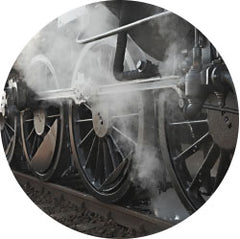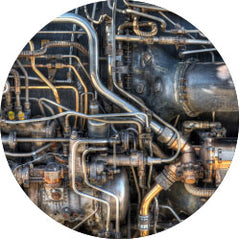 During the mid-1800’s, engineers needed more steam pressure meaning greater strength piping was required. Hence the thickness of the wall of pipes grew to suit the needs.The first requirements for pressurised pipes arose in the Steam Age in the late 1700’s. During this time, the only method of manufacturing pipe was with cast iron.
During the mid-1800’s, engineers needed more steam pressure meaning greater strength piping was required. Hence the thickness of the wall of pipes grew to suit the needs.The first requirements for pressurised pipes arose in the Steam Age in the late 1700’s. During this time, the only method of manufacturing pipe was with cast iron.
These pipes were still made of cast iron and were made to individual engineer’s spec’s meaning there was no conformity.
During the American Civil War in 1862, Robert Briggs (a worker at the Pascal Iron Works in Philadelphia), attempted to standardise the mills in the Pennsylvania area into manufacturing consistent size pipes to help the war effort of the Union.
This became known as the “Briggs Standards”. By 1886 many larger manufacturers had adopted the “Briggs Standard”, especially for threaded steel pipe.
 In 1919 the ASA, using the Briggs Standard Pipe Thread as it basis created the National Pipe Taper (NPT) pipe threads and published the standard complete with all taper pipe and straight pipe specifications and gaging.In 1905, the American Standards Association (ASA) was started by the American Society of Mechanical Engineers and government and military agencies, with the purpose of developing the standards could be used nationally across the USA.
In 1919 the ASA, using the Briggs Standard Pipe Thread as it basis created the National Pipe Taper (NPT) pipe threads and published the standard complete with all taper pipe and straight pipe specifications and gaging.In 1905, the American Standards Association (ASA) was started by the American Society of Mechanical Engineers and government and military agencies, with the purpose of developing the standards could be used nationally across the USA.
The “Briggs Standards”, was eventually adopted as the American Standards in the 1920’s. The word nominal, meant just that, about, or close to.In 1927, the American Standards Association surveyed the industry, and began to use the term “Schedule” (SCH), to identify the different thicknesses of Pipe. “Nominal Bore’ and “Nominal Pipe Size”, NB and NPS is very loosely related to the inside diameter in inches, and NPS 12 and smaller pipe has outside diameter greater than the size designator. For NPS 14 and larger, the NPS is equal to 14inch.
Today the following Schedule sizes are used across the industry. SCH 5, 5S, 10, 10S, 20, 30, 40, 40S, 60, 80, 80S, 100, 120, 140, 160, STD, XS and XXS.
Download: Pipe Size Reference Chart











